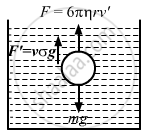Advertisements
Advertisements
प्रश्न
A metal sphere of radius 1 mm and mass 50 mg falls vertically in glycerine. Find (a) the viscous force exerted by the glycerine on the sphere when the speed of the sphere is 1 cm s−1, (b) the hydrostatic force exerted by the glycerine on the sphere and (c) the terminal velocity with which the sphere will move down without acceleration. Density of glycerine = 1260 kg m−3 and its coefficient of viscosity at room temperature = 8.0 poise.
उत्तर
Given:
Radius of metallic sphere r = 1 mm = 10−3 m
Speed of the sphere v = 10−2 m/s
Coefficient of viscosity η = 8 poise = 0.8 decapoise
Mass m = 50 mg = 50 × 10−3 kg
Density of glycerin σ = 1260 kg/m3
(a) Viscous force exerted by glycerine on the sphere F = 6πηrv
⇒ F= 6 × (3.14) × (0.8) × 10−3 × (10−2)
= 1.50 × 10−4 N
(b) Let V be the volume of the sphere.
Hydrostatic force exerted by glycerin on the sphere
\[F' = V\sigma g\]
\[\Rightarrow F' = \frac{4}{3}\pi r^2 \sigma g\]
\[= \left( \frac{4}{3} \right) \times \left( 3 . 14 \right) \times \left( {10}^{- 6} \right) \times 1260 \times 10\]
\[ = 5 . 275 \times {10}^{- 5} \text{N}\]
(c) Let the terminal velocity of the sphere be v'.
The forces acting on the drops are
(i) The weight mg acting downwards
(ii) The force of buoyance, i.e., \[\frac{4}{3}\pi r^3 \sigma g\] acting upwards
(iii) The force of viscosity, i.e., 6πηrv' acting upwards
From the free body diagram:

\[6\pi\eta r v' + \frac{4}{3}\pi r^3 \sigma g = \text{ mg}\]
\[ \Rightarrow v = \frac{\text{ mg }- \frac{4}{3}\pi r^2 \sigma g}{6\pi\eta r}\]
\[ = \frac{50 \times {10}^{- 3} - \frac{4}{3} \times 3 . 14 \times {10}^{- 6} \times 1260 \times 10}{6 \times 3 . 14 \times 0 . 8 \times {10}^{- 3}}\]
\[ = \frac{500 - \frac{4}{3} \times 3 . 14 \times {10}^{- 3} \times 1260 \times 10}{6 \times 3 . 14 \times 0 . 8}\]
\[ = 2 . 3 \text{ cm/s }\]
APPEARS IN
संबंधित प्रश्न
Fill in the blanks using the word(s) from the list appended with each statement
Viscosity of gases. .. with temperature, whereas viscosity of liquids . . . with temperature (increases / decreases)
(a) What is the largest average velocity of blood flow in an artery of radius 2 × 10–3 m if the flow must remain laminar? (b) What is the corresponding flow rate? (Take viscosity of blood to be 2.084 × 10–3 Pa s).
In Millikan’s oil drop experiment, what is the terminal speed of an uncharged drop of radius 2.0 × 10–5 m and density 1.2 × 103 kg m–3? Take the viscosity of air at the temperature of the experiment to be 1.8 × 10–5 Pa s. How much is the viscous force on the drop at that speed? Neglect buoyancy of the drop due to air.
The viscous force acting between two layers of a liquid is given by \[\frac{F}{A} = - \eta\frac{dv}{dz}\]. This F/A may be called
A raindrop falls near the surface of the earth with almost uniform velocity because
The unit of viscosity is
Which has greater viscosity, oil or honey? Why?
With an increase in temperature, the viscosity of liquid and gas, respectively will __________.
Distinguish between streamlined flow and turbulent flow.
What is Reynold’s number? Give its significance.
Define terminal velocity.
Derive Poiseuille’s formula for the volume of a liquid flowing per second through a pipe under streamlined flow.
The velocity of a small ball of mass M and density d, when dropped in a container filled with glycerine becomes constant after some time. If the density of glycerine is `"d"/2` , then the viscous force acting on the ball will be ______.
Is viscosity a vector?
The velocity of a small ball of mass 0.3 g and density 8 g/cc when dropped in a container filled with glycerine becomes constant after some time. If the density of glycerine is 1.3 g/cc, then the value of viscous force acting on the ball will be x × 10-4 N, and the value of x is ______.
[use g = 10 m/s2]
A liquid of density ρ and coefficient of viscosity η flows with velocity v through a tube of diameter D. A quantity `"R" = (rho"vD")/η`, determines whether the flow will be streamlined or turbulent. R has the dimension of ______.
Define the coefficient of viscosity.
State the formula and S.I. units of coefficient of viscosity.
State and explain Newton's law of viscosity.
